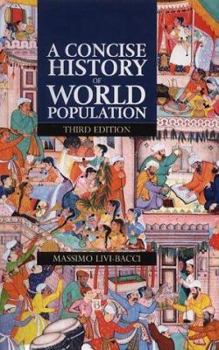A Concise History of World Population
Select Format
Select Condition 
Book Overview
The new edition of this standard history of world population has been updated to include projections to the year 2050. It includes a new section on the effects of HIV on mortality and has expanded discussion of the geopolitical implications of demographic increase on different regions of the world.
Format:Paperback
Language:English
ISBN:0631223355
ISBN13:9780631223351
Release Date:July 2001
Publisher:Wiley-Blackwell
Length:251 Pages
Weight:0.85 lbs.
Dimensions:0.8" x 6.0" x 9.0"
Customer Reviews
2 ratings
still growing
Published by Thriftbooks.com User , 18 years ago
This book excels at providing an integrated and comprehensive look at the global population. Studying many trends that have brought us [the world] to the current state of affairs. Like the lowering of fertility across the developed countries. Such that many are now below replacement rates, signalling a future dimunition of population unless immigration is increased. There are explanations of various models of correlations between demographic and population growth. Though many of these are untested and somewhat empirical. The text also looks at poor countries. Where the situation is often starkly different. While fertility rates have often fallen, these are usually still above replacement rates. Leading some countries to expect continued demographic pressures to maintain, let alone improve, living standards. Unfortunately, the best available data suggests that the world population will still increase, topping out [we hope] at 9 billion by 2050. It could be grim.
Human population growth as an engine of human history
Published by Thriftbooks.com User , 25 years ago
Currently, population studies are often population polemics. Two major groups of scholars make the history of human population a battle ground today. The Neo-Malthusians, following Thomas Malthus (d.1834),and currently represented by Paul Ehrlich and Lester Brown,argue that population growth is dangerous and will deplete the world's resources. Others, beginning with Adam Smith (d.1790) and currently best exemplified in the works of Ester Boserup and Julian Simon, argue that population growth leads to higher standards of living and economic growth. Massimo Livi-Bacci adheres to neither group, but presents a balanced work which examines critically the claims of both sides. Livi-Bacci is one of the great historians of human population of our age. His title suggests that this is a survey of previous studies of population. It is. But it is more than that. It is also a unique work of scholarship. Livi-Bacci presents new work which clarifies and extends our understanding of how population growth has affected past history and how it will continue to affect our lives in the future. It is well written. The style is clear and concise. It is suitable for the generalist as well as the specialist. It is a joy to read.There are only two faults that I feel mar this book. The first is that Livi-Bacci pays less attention to the effects of the Demographic Transition than it seems to merit. The second is that there is no summary bibliography. Yet if one wishes to look at one book which reveals how powerfully human population growth has affected human history, this would be the book to choose.






